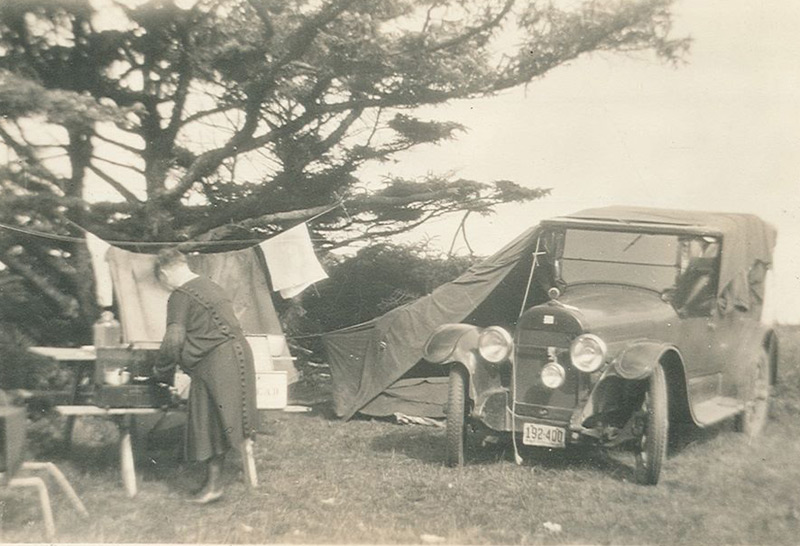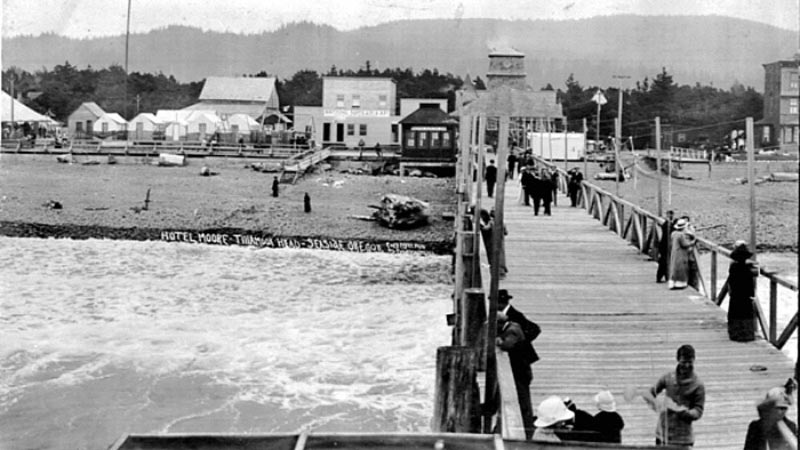From Rugged Tents to Real Rooms: Evolution of Oregon Coast Overnight Stays Part 1
Published 02/19/21 at 6:26 PM PDT
By Oregon Coast Beach Connection staff

(Oregon Coast) – It took about three decades after settlers began occupying the Oregon coast for tourism in the region to begin. Most of the land claims really began in the 1850s or so, and then it took until about 1880 for trains to connect the valley to beach towns. (Photo above: auto camp at Simpson Park in North Bend, 1930s; courtesy Coos History Museum)
Lodging out here began in about as rough ‘n tumble a manner as those early homesteads. Just about every place to stay was a mere tent, where you were at the mercy of this region's weather and had to share restrooms with everyone else.
Includes exclusive listings; some specials in winter
In Cannon Beach:
Includes rentals not listed anywhere else
In Manzanita, Wheeler, Rockaway Beach:
Some specials for winter
In Pacific City, Oceanside:
Some specials for winter
In Lincoln City:
Some specials for winter
In Depoe Bay, Gleneden Beach:
Some specials for winter
In Newport:
Look for some specials
In Waldport
Some specials for winter
In Yachats, Florence
Some specials for winter
Southern Oregon Coast Hotels / Lodgings
Reedsport to Brookings, places to stay; winter deals
The history of tourist lodging on the Oregon coast runs an interesting evolutionary route: from tent cities, to cabins, auto parks, a unique thing called motor lodges, and then finally to motels, with hotels running a parallel existence in some ways.
Here begins Part 1 of the history of Oregon coast places to stay. Auto Camps to Motor Lodges and Motels on Oregon Coast | History Part 2
On the north Oregon coast, tourism started off sooner as trains started coming to Seaside from Portland about 1880. On the southern coast – according to the Coos History Museum and the Oregon Coast Historical Railway Museum in Coos Bay – it wasn’t until 1916 that trains brought visitors there. In some places, like Newport, people started coming by boat first.
What seems to be the first actual hotel built on the coast was at Seaside, called the Sea-Side, built in 1871. It wasn’t called Seaside yet, but that’s actually where the town got its name – not because of its proximity to the ocean. Founding fathers named it after railroad tycoon Ben Holladay’s hotel.
It was a sprawling luxury resort that came complete with a race track, definitely not in the budget for the common man. Average folk were staying in mere tents close to the beach. Most coast towns didn’t really have many of these until about 1900, but then entire tent cities arose in most.
One remarkable example is tiny little Oceanside in 1910 (before it had the name). By then, some 500 tents were available to rent, and the town was a bigger resort than most. However, the beginning of World War I killed that, and all the tents were converted to house soldiers waiting to ship out to Europe.
About 1900, other towns got hotels, like Newport’s Abbey Hotel and a couple more in Seaside. Parts of Tillamook County started getting inns and such as well. Yet most were still using tents through the mid 1920s. Consequently, tourism was just a summer thing. There was no storm watching season back when flimsy stretches of canvas were your lodging. In fact, even when hotels and motels had become commonplace by mid century, it wasn’t until the late ‘70s that people started coming out to the coast in winter with any frequency. Even then, it took until the ‘90s for that to become popular.

From Oregon State Archives: camping with your rig on the Oregon coast, date unknown. OSA said this photo was part of a divorce case.
Another challenge with tents were bathroom facilities. It’s not clear exactly what each tent “resort” had (there were numerous resorts made of tent cities), but it is known is that by the ‘20s, as natatoriums became popular, these facilities had pay toilets and showers for local guests. You did have to pay a quarter or so to relieve yourself, however, and they were public toilets. Yuck. Not every place had natatoriums, either: these were limited to Seaside, Cannon Beach, Newport, Bayocean and Rockaway Beach.

Seaside and its pre-Prom
pier, circa 1910. Note the tents. To the right, cut off in the picture, is one of the first hotels. Courtesy Seasidde Visitors / Seaside History Museum.
By around 1910, tourism was becoming a real industry. Certainly the initial years of Bayocean on the Tillamook Spit (the resort town that largely fell into the sea by the ‘30s) was evidence of this, as miles of paved roads were built and more than 100 lots were sold. People were plopping down tents there as well as hard-walled cottages.
One 1914 article in an early version of The Statesman Journal touts some 100,000 people were expected to visit the Tillamook Coast area that year. Tourism took a bit of a break during the World War I years in some areas, but just before that you could see cottages and more inexpensive inns start to change the landscape.
Finally, in the early ‘20s a new trend began for the average visitor, enabled by the advent of some road system to the coast and cars. It’s then that hard-walled cottages started to emerge all over in greater numbers. Meanwhile, there was no Highway 101 through here. That didn’t really happen until the mid-20s, and even then it wasn’t completed until the ‘30s.
The 1920s brought a rapid change to tourism, starting with the growth of actual cottages. It’s then that the auto camp came into being: a short-lived but integral evolutionary step from rugged, gnarly tent vacations to the pure Americana delights of the motor lodge, and then into motels / hotels for everyone.
See part two Auto Camps to Motor Lodges and Motels on Oregon Coast | History Part 2 . MORE PHOTOS AND DESCRIPTIONS BELOW
Oregon Coast Hotels in this area - Where to eat - Maps - Virtual Tours
Cannon Beach Lodging
Nehalem Bay Lodgings
Manzanita Hotels, Lodging
Three Capes Lodging
Pacific City Hotels, Lodging
Lincoln City Lodging
Depoe Bay Lodging
Newport Lodging
Waldport Lodging
Yachats Lodging
Oregon Coast Vacation Rentals
Oregon Coast Lodging Specials

Ad for Rockaway Beach's Elmore Hotel in 1914. Note the racist restrictions

Ad for Bayocean in 1914, when the resort was at its height
More About Oregon Coast hotels, lodging.....
More About Oregon Coast Restaurants, Dining.....
LATEST Related Oregon Coast Articles
Through 2 a.m. likely best, but some lights possible through dawn June 1 - 2. Space weather, astronomy
Rare Sperm Whale Stranding on N. Oregon Coast, Was Hit by Boat
Showing up near Gearhart, it will decompose naturally. Marine sciences
Coast Guard Barque 'America's Tall Ship' Coming to Portland Rose Fest, N. Ore...
Portland events: June 5 - 8; Astoria events June 13 - 15. Weather
Bright and Active Arietids Meteors May Hit Pre-Dawn Hours of Oregon, Washingt...
Look to east hour before sunrise and you may catch a show. Sciences, astronomy, weather
Why Now Could Be a Great Week for Spotting Killer Whales on Oregon Coast - Video
A good dozen documentations around Depoe Bay, Newport, Coos Bay, Bandon, Tillamook. Marine sciences
Summer Road Work, Traffic Issues Along Oregon Coast Include Astoria, Garibald...
Some daylight closures include bridges, OR 22, OR 18, OR 26, more. Travel tips. Seaside, Cannon Beach, Lincoln City. Travel tips
Pacific City Oregon Weather, 7-Day Forecasts, Live Conditions, Radar, Webcams...
Updated Constantly: Pacific City, Tierra Del Mar, Oregon Weather, Cams, Buoy Observations, Tides, Warnings - Alerts
Oregon Coast Has World's Oldest Harbor Seal, Celebrating 50 Years Soon
June 3 at Oregon Coast Aquarium in Newport. Newport events
Back to Oregon Coast
Contact Advertise on BeachConnection.net
All Content, unless otherwise attributed, copyright BeachConnection.net Unauthorized use or publication is not permitted



















































